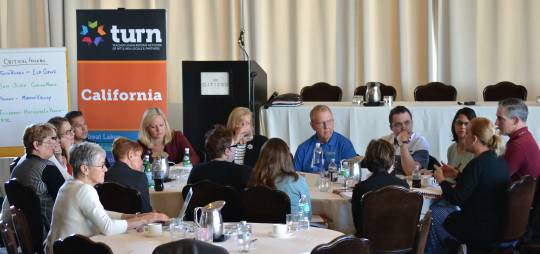This post originally appeared at EdWeek Teacher on March 9, 2015.

While most of my focus this year has been dedicated to visiting schools around California, I'm also making time for professional activities, most recently attending the California regional meeting of the Teacher Union Reform Network (CalTURN). As the virtual community organizer for the network, and as a member of its steering committee, I've had the pleasure of observing some excellent work at these meetings in recent years. At the national level, TURN has been focused on labor-management collaboration, supporting the efforts of union and district leaders to build working relationships that are less adversarial, more productive and solution-oriented.
Here in California, people attending CalTURN meetings usually come in teams including union leadership, other teacher leaders, site and district administrators. These teams spend most of their time over two days working together, or talking with teams from other districts. The focus in recent meetings has been on new state funding regulations and accountability programs. In a shake up the status quo that their critics claim they defend, our state leaders have for the most part declined to pursue the education reform model preferred in Washington, D.C., and instead focused on new approaches. We're using broader measures, for non-punitive purposes, implemented on a relatively gradual timeline.
Questions of how to manage increased local flexibility, and how to meet the law's expectations for stakeholder participation, generate varied answers across districts. These semi-annual meetings create a time and space for tackling the issues together, with resources and consultation available as well. And while all of the individual teams are grounded in their unique contexts and with their unique membership, each meeting seems to have themes that resonate, moments that caputre the attention and imagination of the broader congregation. At the March 5-6 meeting in Sacramento, the moment that stood out for me and others I spoke with came during a panel presentation by the team from Corona-Norco Unified School District.
Panelists included the president of the teachers association and three administrators. Assistant Superintendent Dr. Sam Buenrostro was talking about how the central office addresses its mandates around new policies and school improvement more broadly. Their daily awareness district goals, communication among themselves, and ability to focus on the needs of the moment all contribute to a sense of urgency around their work. From that position it's obvious what needs to be done, and natural to push site administrators and teachers to speed up, accelerate the work that advances those goals. Buenrostro then said that, of course, the school leaders at the site level are responding to him to slow down, and the teachers are saying stop. On that note, association president Harold Stryker took up the issue from the school perspective.
It's not that principals or teachers have anything against school improvement - and Buenrostro wasn't suggesting otherwise. Rather, principals find themselves in the middle of the relationship between the district and its teachers. Ask enough teachers about good principals and you'll often hear mention of how the principals shield their teachers, protect their time and autonomy (to the extent they have it). Principals are more aware than district administrators what the mood is like at a school, and how new initiatives are being received by the teaching staff. Changes that sound modest and simple at the district level may necessitate days or weeks of focused time to implement properly. Memories of prior changes that were poorly explained or implemented, or quickly abandoned, make teachers understandably reluctant to give up precious time. Lack of transparency regarding the purpose, process, or rationale relating to change can also undermine proposals from the start.
What made the exchange on this panel so remarkable wasn't the idea that teachers are stretched thin and have perspectives different from those found in the central office. Rather, it was the calm, even humorous way that the panelists described the division, owned it, and presented it as a challenge of mutual interest. The authenticity of their struggle and the lack of prescriptive responses made the discussion real and resonant. We can't resolve these differences entirely, nor should we try. States and districts have a legitimate interest in defining goals and setting directions for schools. Teachers have legitimate reasons to push back and force leaders and policymakers to confront school and classroom realities that must be addressed.
Living with the ambiguity, the occasional dissonance, and remaining positive - that's what the team from Corona-Norco seemed to have achieved, and modeled for the rest of the group. To the extent that we can all recognize and accept multiple perspectives, engage in vigorous debate, and still work constructively together, we'll surely see some better outcomes ahead.




